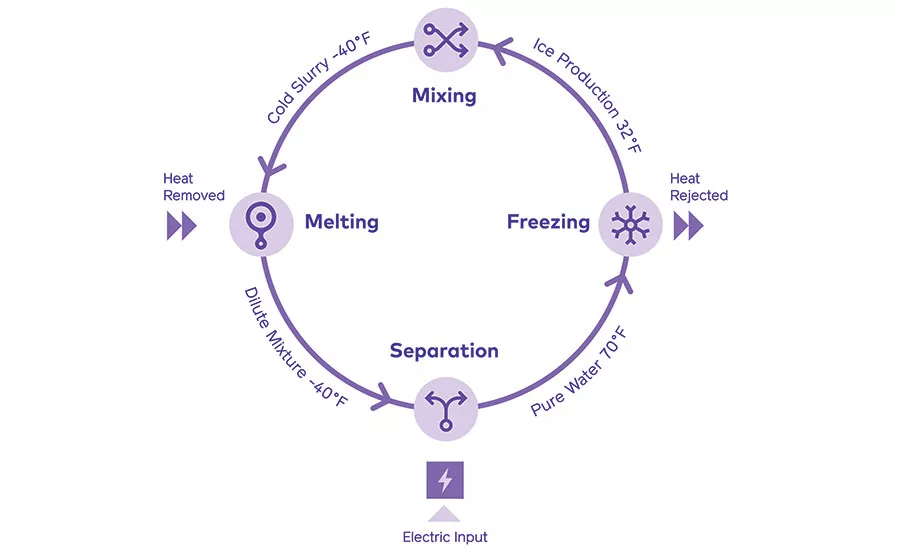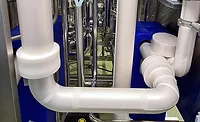Engineering R&D
IcePoint saves energy via on-demand agile cooling and moisture control

Kevin Davis, CEO and cofounder of Rebound

The IcePoint cycle consists of four phases: (1) Freezing: Pure water is frozen at the most economical time of the day and stored in a tank; (2) Mixing: A freeze suppressant is then injected into the bottom of the tank, mixing with the ice, which creates a -40°F refrigerant; (3) Melting: This refrigerant mixture is then used to maintain facility freezer temperatures by absorbing the heat from the freezer space; (4) Separation: Water is then mechanically separated from the freeze point suppressant. Pure water is ready to freeze, on demand, while the concentrated freeze suppressant is reinjected into the ice tank.
Illustration courtesy of Rebound Technologies
Not a whole lot has changed in conventional refrigeration technology in the last 160 years. It’s a little like the internal combustion engine. We’ve made several strides in the supporting technologies developed around it, but it’s still the same engine technology (crankshaft, pistons, valves, etc.) developed over a century ago. So, it’s pretty much the same with vapor compression technology—just iterative component improvements with very little impact on end users’ financial bottom line. Until now.
Colorado-based Rebound Technologies, founded in 2012 by CEO Kevin Davis and CTO Russell Goldfarbmuren, has taken a new approach to refrigeration with its IcePoint technology, focusing its efforts on developing highly agile systems to match perfectly the dynamic thermal needs of a business. Though not a “battery-like” thermal storage system, IcePoint can indeed create a -40°F refrigerant at night by mixing ice with a freeze point suppressant (i.e., a salt) during off-peak hours, and then during the day, deploying the brine refrigerant to provide required cooling and moisture control. The mixture is eventually separated into pure water and freeze suppressant, reusing both as the closed-loop cycle continues. This architecture allows IcePoint to deploy cooling at the exact time needed, in the quantity needed.
According to Goldfarbmuren, modeling indicates the IcePoint technology, at optimal design, uses up to 35% less energy than conventional systems while achieving additional cost savings by utilizing lower off-peak energy rates. I asked Davis what applications in food and beverage could benefit from the new technology, and he said blast freezing at large-scale refrigerated warehouses, but an even better application is in spiral, tunnel and IQF freezers.
“Today’s vapor compression systems are designed to accommodate a specific cooling load, and perform very poorly when tasked to do anything different,” says Davis. As they can’t fulfill the needed cooling capacity for a particular job, they end up consuming more energy while cooling more slowly.
“Rebound has created an entirely new cooling cycle—one that’s founded on agility and the need to adapt to fluctuating cooling demands,” says Davis. “Our value is that we can provide dynamic cooling capacity, allowing customers to be more flexible with production goals by providing bursts of on-demand low-temperature cooling and moisture control, which allows an acceleration in the freezing process of food.”
FE: How does the IcePoint cooling cycle differ from conventional vapor compressor systems?
Kevin Davis: Vapor compression moves heat by changing the pressure of a refrigerant, a process that requires energy-intensive compressors. IcePoint, instead, changes the chemical composition of a refrigerant.
There are three primary stages: charging, discharging and regeneration. To charge the system, we leverage electricity to generate ice at 32°F, but then use freeze point suppression (i.e., the addition of salt) to produce a -40°F refrigerant. To discharge, we track the needs of the facility, deploying just the right amount of brine refrigerant at the exact time it is required. Finally, we regenerate our refrigerant by separating it back into water and salt, allowing us to continue the closed-loop process.
The primary benefit is agility. Ramping up and down between 28 TR (tons of refrigeration) and 140 TR of -40°F cooling capacity enables strategic bursts of cooling, which are incredibly beneficial for accelerating freezing processes. Furthermore, the architecture allows the three stages to operate independent of one another, allowing the customer to economically optimize their electricity consumption.
FE: Why is it not a “thermal battery”?
Davis: The technology has all the flexibility of a thermal battery, which enables it to mitigate peak energy costs, but the architecture itself is quite different. First, no thermal battery can deploy dynamic cooling capacity. Just like vapor compression, thermal battery capacity is fixed. Second, thermal batteries can never operate at an efficiency gain over vapor compression systems because they are using traditional systems to ‘charge’ them.
FE: Is the system meant to replace a conventional system or supplement its capacity?
Davis: Initial units will be deployed in supplemental configuration to validate the technology as reliable integrations. Therefore, once a unit is installed, the existing ammonia infrastructure at both food processors and refrigerated warehouses will continue to operate normally, regardless of whether IcePoint is flowing refrigerant.
FE: How do you integrate IcePoint with an existing warehouse system? What are the advantages?
Davis: IcePoint integrates into a refrigerated warehouse via a liquid sub cooler. This is a diffusion bonded heat exchanger that’s installed prior to the low temperature recirculator used to provide refrigerant to the blast cell evaporators. During the first 30% of a blast freezing cycle, there is such a significant amount of heat to remove that engine rooms often don’t have the capacity to maintain the set point suction temperatures. During these periods, IcePoint flows -40°F brine refrigerant to the engine room, sub-cooling the liquid ammonia. The more support the ammonia system requires, the faster IcePoint flows brine.
FE: What are its benefits with a standalone IQF/spiral freezer system? Can the IcePoint/IQF system operate independently of the existing cooling system?
Davis: IcePoint integrates into a continuous freezer via an air heat exchanger, where warm, moist air is extracted, cooled, dehumidified and sent back into the freezer cold and dry. Two strategically-placed integration points extract the warm, moist air and then reinject it prior to the evaporator coils. In configuration adds cooling power, reduces frosting on the existing ammonia coils and boosts product yields.
FE: Does the IQF/spiral freezer require additional coils to accommodate IcePoint?
Davis: Initially, IcePoint is deployed as supplemental units and thus doesn’t require additional coils. Per the integration mentioned previously, we simply install an air heat exchanger, avoiding any direct interaction with ammonia, while providing supplemental cooling capacity and moisture control as needed.
FE: Are you currently working with any food companies? What applications?
Davis: In 2018 we piloted a proof-of-concept system with a refrigerated warehouse company. We very recently deployed a production unit to that same customer, the results of which will be available in the coming months. We are currently engaged with multiple food processing companies regarding spiral freezer integrations and hope to have a production unit boosting revenues for food processors by the end of summer.
FE: When do you see IcePoint being available?
Davis: IcePoint is available today. Rebound is currently manufacturing units for deployment and planning to scale operations to meeting demand in 2021.
FE: Any future predictions?
Davis: Partnerships continue to represent the best path forward. As an organization, it would be beneficial to line up a collaboration between a large end user, a spiral/tunnel OEM and forward-thinking contractor to deploy, monitor and support continuous improvement of the product. There aren’t any differentiating technologies in refrigeration. IcePoint represents a large innovative leap forward. Those facilities that adopt IcePoint will have an unprecedented competitive advantage in the food production and refrigerated warehouse sector.
For more information, visit www.rebound-tech.com
Looking for a reprint of this article?
From high-res PDFs to custom plaques, order your copy today!






